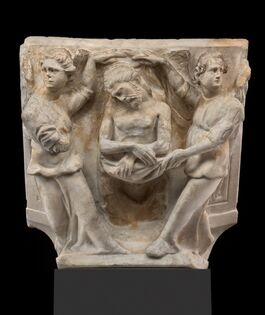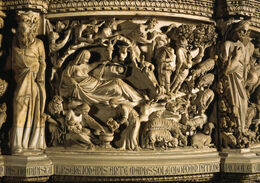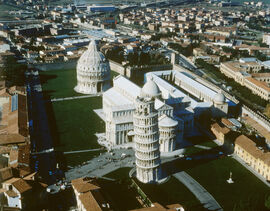
Brief Identification:[]
This sculpture is the work of Italian artist Giovanni Pisano, and was originally part of the pulpit in the Cathedral of Pisa [1] in Pisa, Italy. Constructed in the region of Tuscany between 1302 and 1310, this piece reflects the style of highly emotional work associated with the Romanesque style of art [2]. Serving as an adornment on the pulpit before it was “dismantled after a fire in 1595” (Cristiani n.d.), this relief depicts the unshrouded upper body of a deceased Jesus and two angels on either side, and has suffered moderate damage since its separation from the pulpit. It currently resides in the Bode Museum in Berlin, Germany[3].
Technical Evaluation:[]
The Man Of Sorrows is a marble relief in the Romanesque style that was originally attached to the Pisa Pulpit. Built between the years of 1302 and 1310, it was the second of which Pisano had constructed at the time. There are several marble components that, like this piece, were placed into storage when the cathedral was rebuilt [4]. Sadly, “several of the carvings were separated and some were lost, making it impossible to return the pulpit to its original appearance” (Gòmez-Moreno 1972). Pisano, while not adopting any advanced technologies, used stylistic elements characteristic of Romanesque religious sculptures-- "greater realism...emotion...and immense and intricate relief carvings" (Madeleine Pelner Cosman 2008)-- in the extreme. Known for the dramatic features and use of space in his work, Pisano plays with “truly three

Nativity, Giovanni Pisano
dimensional [figures]”(Kalina 2003). His stonework possesses an element of movement that evokes emotion in the observer [5]. His legacy is “detected in the motion…freely developed in space” (Kalina 2003), that is present both in Man of Sorrows and in the pulpit as a whole. Each piece, whether depicting the crowded scenes like Nativity [6] or the simple three above, develops a slab of marble into a space that allows for the movement of stone—a trait one may argue is iconic of Pisano. Some of his trademark artistry-- the emotion, the space, the fluidity-- has been lost to the pulpit since its reconstruction[7]. While "the iconography of the pulpit [has been] retained...the spatial relationship has been sacrificed" (Dent 2008). Peleo Bacci's reconstruction, though "conscientious and rather convincing" (Gòmez-Moreno 1972), fails to stay true to Pisano's intended structure of space. While there is little available information about how exactly this piece was discovered, The Ladies' Repository magazine from January through July of 1872 makes a note of "a recent discovery, at Pisa, of the parts of a celebrated pulpit, in marble, by the great artist, Giovanni Pisano" (The Ladies' Repository 1872).
Local Historical Context:[]
The time frame in which Pisano constructed the pulpit falls into the Medieval Period of world history. During this time period, people lived "approximately [to] age 33" (Madeleine Pelner Cosman 2008) It is because of this that practices like child marriage and early apprenticeship occurred for "dynastic, political, and economic purposes" (Madeleine Pelner Cosman 2008). For example, a young Pisano apprenticed under his father, Nicola Pisano [8]. This time period was also pivotal in the development of the Roman Catholic Church during the later period of the Renaissance. The papacy was split between Roman and French camps which was

The Cathedral of Pisa, view of complex
resolved in 1303 with the death of Pope Boniface VIII of Rome, because, after his death, all of the popes elected were done so in the interest of France (Madeleine Pelner Cosman 2008), solidifying Catholicism as a state supported religion in Europe. This period referred to as "Babylonian Captivity" (Madeleine Pelner Cosman 2008) also saw a shift to the main source of papal financing from "simony and indulgences" (Madeleine Pelner Cosman 2008). Churches often acted as patrons to artists like Pisano, so that patrons footed the bill for the works of artists in return for the artist producing the piece they desired. The Man of Sorrows, while a piece of an entire work, represents this patronage and the influence Christianity had on art in this region during this period in time. The Church could afford to commission these masterpieces due to its growing power, thus artists working under patronage created religious works of art. This is reflected by Man of Sorrows, as it is not only exemplary of Romanesque art, but of the church sponsored content that artists were given the ability to operate under. The Church as a patron created a unique dynamic to the so-called "patron-artist relationship" (Madeleine Pelner Cosman 2008), because the art was not being created solely for one individual or a single family, but for anyone who entered the building to worship. Artists were not simply producing sculptures, buildings, or glass-works-- they were the creators of devotional objects.
World - Historical Significance:[]
Within the larger confines of world history, this piece represents the development of the Christian branch of Catholicism as a "universalizing faith that transformed the region known as 'Europe'" (Robert Tignor 2014). As reflected by the emotional work of Pisano, Catholicism became an orthodoxy centered around "daily remorse and daily contemplation of the sufferings of Christ" (Robert Tignor 2014). Practicing Catholics united around cultural objects like the Pisa Pulpit, not only because they were masterpieces of artistry, but because they were symbolic of the act of worship itself. This life of reflection and dedication was reflected throughout the Europe of the 1300's in intellectual studies, the involvement of the church in private life, as well as the persecution of non-Christians, and because this lifestyle was widespread across Europe, the continent was "more culturally unified than in previous centuries" (Robert Tignor 2014). This piece, in a greater context, is symbolic of the rise of the Roman Catholic Church in Europe as both a religious and administrative body that provided structure far beyond that imagined by Giovanni Pisano. It is both a devotional object-- one that Christians may use to reflect on the life of Christ-- and an object of means-- one that reflects the necessity of the Catholic church to art through patronage of artists like Pisano.
Bibliography:[]
Archer, Madeline Cirillo. 2014. "Nicola Pisano and Giovanni Pisano." Salem Press Biographical Encyclopedia (Salem Press Biographical Encyclopedia) 1-3. Accessed April 20, 2015. http://eds.b.ebscohost.com/eds/detail/detail?vid=10&sid=226a2e2e-a615-4194-96c4-dcb7b9fb78c1%40sessionmgr114&hid=104&bdata=JnNpdGU9ZWRzLWxpdmU%3d#db=ers&AN=92667846.
Cristiani, Maria Laura Testi. n.d. Pisano (i). Prod. Grove Art Online. Oxford University Press. Accessed April 14, 2015. http://www.oxfordartonline.com.proxy-remote.galib.uga.edu/subscriber/article/grove/art/T067893pg2.
Dent, Peter. 2008. ""Laude Dei Trini": Observations Towards a Reconstruction of Giovanni's Pistoria Pulpit." Journal of the Warburg and Courtauld Institutes (The Warburg Institute) 71: 121-138. Accessed April 18, 2015. http://www.jstor.org/discover/10.2307/20462779?uid=3739616&uid=2&uid=4&uid=3739256&sid=21106503613193.
Gomez-Moreno, Carmen. 1972. "Giovanni Pisano at the Metropolitan Museum Revisited." Chicago Journals (The University of Chicago Press) 5: 51-73. Accessed April 16, 2015. http://www.jstor.org/stable/1512627?seq=1#page_scan_tab_contents.
Kalina, Pavel. 2003. "Giovanni Pisano, the Dominicans, and the Origin of the "crucifixi dolorosi"." Artibus et Historiae (IRSA s.c.) 24 (47): 81-101. Accessed April 15, 2015. http://www.jstor.org/stable/1483761?seq=1#page_scan_tab_contents.
Madeleine Pelner Cosman, Linda Gale Jones. 2008. Handbook to Life in the Medieval World. Vol. I. III vols. New York, New York: Estate of Madeleine Pelner Cosman, Infobase Publishing. Accessed April 20, 2015.
Robert Tignor, Jerry Adelman, Peter Brown, Benjamin Elman, Xinru Liu, Holly Pittman, Brent Shaw. 2014. Worlds Together, Worlds Apart. Fourth. Edited by Jon Durbin. Vol. I. II vols. New York, New York: W.W. Norton & Company, Inc. . Accessed April 20, 2015.
The Ladies' Repository. 1872. "Art Notes." The Ladie's Repository, January - June. Accessed April 20, 2015.
Footnotes:[]
1. Maria Laura Testi Cristiani, "Pisano (i)," http://www.oxfordartonline.com.proxy-remote.galib.uga.edu/subscriber/article/grove/art/T067893pg2?q=giovanni+pisano+the+prophets&search=quick&pos=10&_start=1
2. Eric Fernie, "Romanesque," http://www.oxfordartonline.com.proxy-remote.galib.uga.edu/subscriber/article/grove/art/T072835pg1#T072836
3. Deutsche Digitale Bibliothek, "Engelpieta," https://www.deutsche-digitale-bibliothek.de/item/EGXRSOC3MY7C7MIXT4XGR3GJVLQECFZ4/
4. Carmen Gomez-Moreno, "Giovanni Pisano at the Metropolitan Museum Revisited," http://www.jstor.org/stable/1512627?seq=1#page_scan_tab_contents
5. Pavel Kalina, " Giovanni Pisano, the Dominicans, and the Origin of the 'crucifixi dolorosi'," http://www.jstor.org/stable/1483761?seq=1#page_scan_tab_contents
6. Giovanni Pisano, "Nativity," http://www.oxfordartonline.com.proxy-remote.galib.uga.edu/subscriber/article/img/grove/art/F017162?q=giovanni+pisano&search=quick&pos=4&_start=1#firsthit
7. Peter Dent, "Laude Dei Trini: Observations Towards A Reconstruction of Giovanni Pisano's Pistoria Pulpit," http://www.jstor.org/discover/10.2307/20462779?uid=3739616&uid=2&uid=4&uid=3739256&sid=21106503613193
8. Madeline Cirillo Archer, "Nicola Pisano and Giovannit Pisano," http://eds.b.ebscohost.com/eds/detail/detail?sid=30713ded-d99f-4134-bc8a-1798a6fa2c7a%40sessionmgr198&vid=3&hid=104&bdata=JnNpdGU9ZWRzLWxpdmU%3d#db=ers&AN=92667846